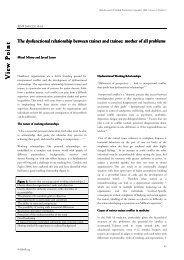R esearch A rticle - British Journal of Medical Practitioners
R esearch A rticle - British Journal of Medical Practitioners
R esearch A rticle - British Journal of Medical Practitioners
You also want an ePaper? Increase the reach of your titles
YUMPU automatically turns print PDFs into web optimized ePapers that Google loves.
<strong>British</strong> <strong>Journal</strong> <strong>of</strong> <strong>Medical</strong> <strong>Practitioners</strong>, March 2013, Volume 6, Number 1<br />
BJMP 2013;6(1):a603<br />
Review A<strong>rticle</strong><br />
Often overlooked neuropsychiatric syndromes in Parkinson’s disease<br />
Javed Latoo, Minal Mistry, and Francis J Dunne<br />
Abstract<br />
Parkinson’s disease (PD) is a subcortical disorder that eventually spreads to the cortex. There is a wide variation in the global incidence and prevalence <strong>of</strong><br />
PD. The disease usually presents in patients over the age <strong>of</strong> 65, although 5% <strong>of</strong> cases are under the age <strong>of</strong> 40 at the time <strong>of</strong> diagnosis. PD has a high<br />
prevalence <strong>of</strong> psychiatric co-morbidity. In this a<strong>rticle</strong>, written with general neurologists and psychiatrists in mind, the main features and pathology <strong>of</strong> PD<br />
will be briefly outlined followed by a review <strong>of</strong> the epidemiology, aetiology, clinical features, and treatment <strong>of</strong> other <strong>of</strong>ten overlooked neuropsychiatric<br />
syndromes associated with PD. Close liaison between neurologists and psychiatrists is recommended in order to optimize treatment.<br />
Introduction<br />
The global epidemiology <strong>of</strong> PD varies widely which could be<br />
partly accounted for by differences in survival rates. 1 One<br />
review paper examined the epidemiology <strong>of</strong> PD in Austria, the<br />
Czech Republic, France, Germany, Italy, The Netherlands,<br />
Portugal, Spain, Sweden and United Kingdom. It revealed that<br />
the prevalence rates range from 65.6 per 100,000 to 12,500 per<br />
100,000 and annual incidence estimates ranged from 5 per<br />
100,000 to 346 per 100,000. 2 The wide variation in incidence<br />
and prevalence rates <strong>of</strong> PD across Europe could be due to<br />
environmental and genetic factors. Differences in<br />
methodologies for case ascertainment, diagnostic criteria, or age<br />
distributions <strong>of</strong> the study populations, could also account for<br />
the wide variations. 2<br />
Described by James Parkinson in 1817, PD is the second most<br />
common neurodegenerative disorder next to Alzheimer’s<br />
dementia. Depletion <strong>of</strong> dopaminergic neurones in the<br />
substantia nigra is the main pathology found in PD. Symptoms<br />
usually appear when dopamine levels are reduced by 50-<br />
80%. 3 Noradrenergic, cholinergic and serotonergic pathways<br />
are also affected. Clinically PD is characterised by rigidity,<br />
tremor (cogwheel, lead pipe, and resting), akinesia, bradykinesia<br />
(poverty and slowness <strong>of</strong> movement), and postural instability<br />
(leading to frequent falls). 4 These symptoms may also be<br />
accompanied by a range <strong>of</strong> non-motor symptoms other than<br />
well-known neuropsychiatric syndromes <strong>of</strong> depression,<br />
psychosis, and cognitive impairment.<br />
In essence, a syndrome is a combination <strong>of</strong> signs and symptoms<br />
related to an underlying pathological process. PD may present<br />
with neuropsychiatric syndromes <strong>of</strong> depression, psychosis<br />
(usually affective in origin) and cognitive impairment. 5 These<br />
syndromes are not under discussion here as readers are likely to<br />
be familiar with them. However, PD may also present with<br />
other neuropsychiatric syndromes and for the purpose <strong>of</strong> this<br />
a<strong>rticle</strong> we have classified them into: 1) Anxiety disorders, 2)<br />
Apathy, 3) Involuntary emotional expression disorder, 4) Sleep<br />
disorders, and 5) Impulse control disorders.<br />
Drugs used to treat PD themselves are associated with<br />
neuropsychiatric side effects. For example, dopamine agonists<br />
are well-known to cause sleep disturbance, dizziness (usually<br />
due to postural hypotension), hallucinations, hypersexuality,<br />
and compulsive gambling. Anticholinergics may cause<br />
confusion, hallucinations and impaired memory. Surgery also<br />
may cause adverse effects including depression, confusion and<br />
cognitive impairment. 6 Table 1 illustrates the groups <strong>of</strong> drugs<br />
used in PD.<br />
Table 1. Drugs used in Parkinson’s Disease<br />
Group<br />
Dopamine receptor agonists<br />
N-Methyl-D-aspartate<br />
(NMDA) receptor antagonist<br />
Levodopa<br />
Monoamine oxidase B<br />
inhibitors (MAO-B)<br />
Catechol-Omethyltransferase<br />
(COMT)<br />
inhibitors<br />
Antimuscarinic drugs<br />
Drug<br />
Apomorphine, pramipexole, ropinirole,<br />
rotigotine<br />
Amantadine hydrochloride<br />
Co-benedopa (levodopa/benzeraside),<br />
co-careldopa (levodopa/carbidopa)<br />
Rasagiline, selegiline hydrochloride<br />
Entacapone, tolcapone<br />
Benztropine mesylate, orphenadrine,<br />
procyclidine, trihexyphenidyl<br />
Overlooked neuropsychiatric syndromes in Parkinson’s disease<br />
The prevalence <strong>of</strong> overlooked neuropsychiatric syndromes<br />
found in PD, summarised in Table 2, is generally less common<br />
than PD syndromes <strong>of</strong> depression (up to 50%),psychosis (up to<br />
7, 8, 9<br />
60%) and dementia (ultimately develops in 80%).<br />
BJMP.org<br />
23







